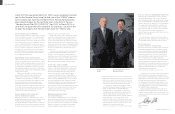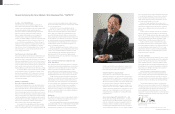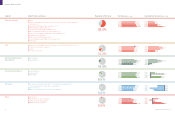Yamaha 2007 Annual Report Download - page 16
Download and view the complete annual report
Please find page 16 of the 2007 Yamaha annual report below. You can navigate through the pages in the report by either clicking on the pages listed below, or by using the keyword search tool below to find specific information within the annual report.
Yamaha Annual Report 2007 3029
Yamaha Livingtec Corporation is moving toward the creation of a
profitable business structure by pursuing a growth strategy built around
system kitchens. To achieve this goal, the company is focusing on
implementing further management structural reforms, including customer-
oriented product fabrication; expanding customer base by upgrading
showrooms and developing remodeling sales channels; and reinforcing
cost competitiveness through fundamental reform of production structures.
Business outline
The lifestyle-related products segment is mainly
composed of system kitchens, system bath-
rooms and vanity units. Yamaha Livingtec
Corporation is the principal Yamaha Group
subsidiary in this segment. Exploiting core
technologies in artificial marble, piano coating
and wood processing, Yamaha aims
to create products that exceed customer
expectations in terms of utility and satisfaction,
leveraging several competitive advantages to
achieve this objective. Besides creating original
and highly functional products of high quality,
Yamaha boasts an integrated development and
production process from materials to finished
product. It also has a national network of
product display showrooms to offer customers
a first-hand look at products and to propose
alternatives for their own homes.
Performance overview
Segment sales exceeded the initial target of
¥43.0 billion by ¥3.6 billion, increasing by ¥1.4
billion, or 3.0%, in year-on-year terms to ¥46.6
billion. In terms of the sales product mix, unit
price of system bathrooms declined due to
fiercer market competition, but sales of system
kitchens increased due to the popularity of
models featuring artificial marble sinks. At ¥1.2
billion, segment operating income was on a par
with the prior year, which reflected the impact
of higher materials prices.
Market trends
Regarding home fixtures and equipment, the
conditions within the Japanese market have
been extremely harsh due to a shift in demand
in the new housing construction sector toward
younger first-time buyers and a resulting down-
ward trend in moderately-priced products.
Additionally, there is increasingly pronounced
polarization between the power builders (strong
regional base house providers), which mainly
cover the sales channel for moderately-priced
products and suppliers of made-to-order
products. The new Basic Law on Housing
came into force in Japan in June 2006. This
is expected to prompt builders to shift from
volume growth strategies toward development
of safe, high-quality housing, as demand for
existing housing stock gains momentum.
Moreover, along with increasingly desirable
aspects such as energy efficiency and universal
design, the future trend among customers is
expected to be toward convenient housing that
combines high resilience with long life.
Business strategy
Driving forces behind growth strategy
Under the “YGP2010” medium-term business
plan, the segment targets for fiscal 2010 are
Review of Operations l Lifestyle-Related Products
on face-to-face customer contact and needs
assessment. Dubbed “Value Up 30,” this set of
policies is guiding the development of business
activities across the company. The results of
these initiatives have started to appear gradually
from the second half of fiscal 2007.
Establishing a user segment-targeted
product lineup
On the product side, based on the concept of
“customer-oriented product planning and devel-
opment,” Yamaha is targeting products that
combine long life and convenience with human-
conscious, environment-friendly functions. At
the same time, Yamaha has established a clear,
user-targeted product categorization of luxu-
ry/moderately-priced/entry-level, proposing
“Value for Money” based on Yamaha’s distinc-
tive blend of style and function.
In addition, Yamaha plans to develop new
business models to support the establishment
of additional business units that will offer
semi-custom order products for the luxury
sector and built-to-order products for the
super-luxury sector.
In system kitchens, the company plans
to further upgrade the berryTM range of moder-
ately-priced products while seeking to acquire
more users in the luxury sector with the DOLCE
LEGATOTM system kitchen, which was launched
in spring 2007. In system bathrooms, reflecting
the intensely competitive conditions caused by
the current downward trend in unit prices and
other factors, Yamaha aims to improve the cost
competitiveness of its product range in the
moderately-priced sector. Alongside this,
Yamaha is seeking to differentiate its products
from competitors by improving the ease
and convenience of use, ease of cleaning,
spaciousness and quality of fabrication.
Expanding points of contact with
customers and affiliated outlets
The company aims to expand its business by
focusing mainly on the markets for construction
of built-to-order stand-alone houses and home
remodeling, as designated by the customer
placing the order. To expand points of contact
with customers, Yamaha has expanded
and upgraded its network of showrooms and
converted these into sales bases that function as
Yamaha business centers. Yamaha also plans to
expand the current network of 38 showrooms to
50 outlets by 2010, with most of this growth
planned for the Tokyo metropolitan area.
Yamaha is also striving to raise consumer
awareness by aggressively conducting adver-
tisement and promotional campaigns, mainly
targeting magazine media. These efforts are
proving successful in steadily increasing cus-
tomer recall for Yamaha as a supplier in the
housing fixtures market. At the same time,
Yamaha is adopting measures to target agents
and sales outlets within the home construction
sector in an attempt to expand the network of
affiliated outlets that provide a sales channel
for the home remodeling sector. In Japan
there are around 180,000 building contractor
firms at present, and the company currently
deals with 6,000 firms. Plans call for increasing
this latter figure to 25,000 by 2010.
Promoting fundamental reform of
production structures
Besides these initiatives, attaining the highest
levels of cost competitiveness within the industry
System bathroom BeautTM
System kitchen berryTM
System kitchen DOLCE LEGATOTM
System kitchen berryTM
¥56 billion in sales and ¥3 billion in operating
income. To achieve these goals, Yamaha is
targeting ongoing structural reforms and the
establishment of a profitable business structure
based on six core policies: fundamental reform
of production structures; customer-oriented
product planning and development; growth
in the customer base; quality assurance
exceeding customer expectations; profit-oriented
business management; and marketing based
is an important issue in achieving the
“YGP2010” goals. The company aims to trim
its cost base by a total of ¥3 billion during the
three-year plan period. Through ongoing
reforms involving the revision of factory layouts
and other measures, Yamaha aims to reduce
labor costs by 30% while boosting manufac-
turing productivity by 30%.
























